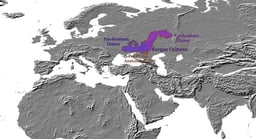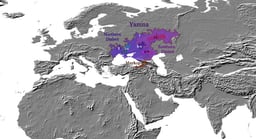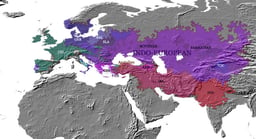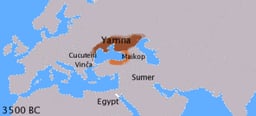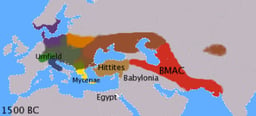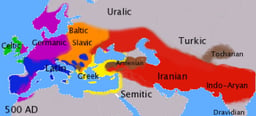Indo-European languages
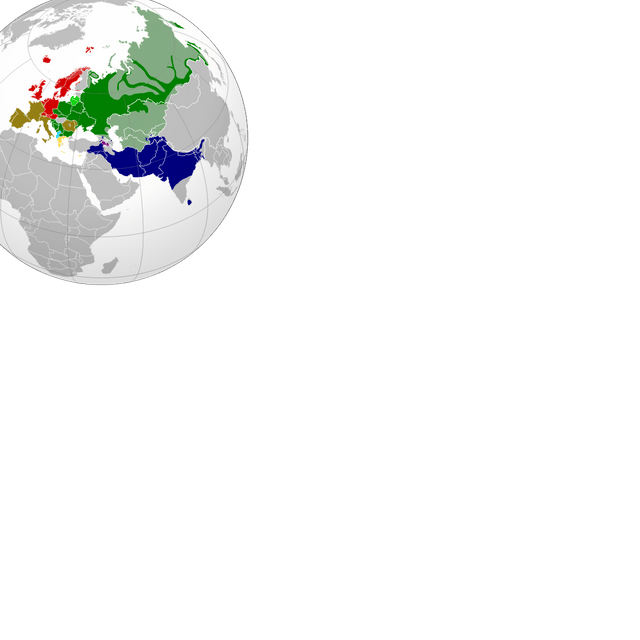
Indo-European languages

| Indo-European | |
|---|---|
| Geographic distribution | Originally parts of Asia and large parts of Europe, now worldwide c. 3.2 billionnative speakers |
| Linguistic classification | One of the world's primary language families |
| Proto-language | Proto-Indo-European |
| Subdivisions |
|
| ISO 639-2 / 5 | ine |
| Glottolog | indo1319 [86][2] |
| Notes |
|
The Indo-European languages are a language family of several hundred related languages and dialects.[3]
There are about 445 living Indo-European languages, according to the estimate by Ethnologue, with over two thirds (313) of them belonging to the Indo-Iranian branch.[4] The Indo-European languages with the greatest numbers of native speakers are Spanish, English, Hindustani (Hindi/Urdu), Portuguese, Bengali, Punjabi, and Russian, each with over 100 million speakers, with German, French, Marathi, Italian, and Persian also having more than 50 million. Today, 46% of the world's population (3.2 billion) speaks an Indo-European language as a first language, by far the highest of any language family.
The Indo-European family includes most of the modern languages of Europe. The language family is also represented in Asia with the exception of East and Southeast Asia. It was prominent (alongside non- Indo-European languages) in ancient Anatolia (present-day Turkey), the ancient Tarim Basin (present-day Northwest China) and most of Central Asia until the medieval Turkic and Mongol invasions. Outside Eurasia, Indo-European languages are dominant in the Americas and much of Oceania and Africa, having reached there through colonialism during the Age of Discovery and later periods. Indo-European languages are also most commonly present as minority languages or second languages in countries where other families are dominant.
With written evidence appearing from the Bronze Age in the form of Mycenaean Greek and the Anatolian languages Hittite and Luwian, the Indo-European family is significant to the field of historical linguistics as possessing the second-longest recorded history, after the Afroasiatic family in the form of the Egyptian language and the Semitic languages of the Near East. In addition, certain extinct language isolates of the Near East and Anatolia, such as Sumerian, Elamite, Hurrian, Hattian, Gutian and Kassite are also recorded earlier than any Indo-European tongue.
All Indo-European languages are descendants of a single prehistoric language, reconstructed as Proto-Indo-European, spoken sometime in the Neolithic era. Although no written records remain, aspects of the culture and religion of the Proto-Indo-Europeans can be reconstructed from the related cultures of ancient and modern Indo-European speakers who continue to live in areas where the Proto-Indo-Europeans migrated from their original homeland.[5] Several disputed proposals link Indo-European to other major language families. Although they are written in the Semitic Old Assyrian language and with the use of the Cuneiform script of Mesopotamia, the Hittite words and names found in the texts of the Assyrian colony of Kültepe in eastern Anatolia are the oldest record of any Indo-European language.[6]
| Indo-European | |
|---|---|
| Geographic distribution | Originally parts of Asia and large parts of Europe, now worldwide c. 3.2 billionnative speakers |
| Linguistic classification | One of the world's primary language families |
| Proto-language | Proto-Indo-European |
| Subdivisions |
|
| ISO 639-2 / 5 | ine |
| Glottolog | indo1319 [86][2] |
| Notes |
|
History of Indo-European linguistics

Franz Bopp, pioneer in the field of comparative linguistic studies.
In the 16th century, European visitors to the Indian subcontinent began to notice similarities among Indo-Aryan, Iranian, and European languages. In 1583, English Jesuit missionary and Konkani scholar Thomas Stephens wrote a letter from Goa to his brother (not published until the 20th century)[8] in which he noted similarities between Indian languages and Greek and Latin.
Another account was made by Filippo Sassetti, a merchant born in Florence in 1540, who travelled to the Indian subcontinent. Writing in 1585, he noted some word similarities between Sanskrit and Italian (these included devaḥ/dio "God", sarpaḥ/serpe "serpent", sapta/sette "seven", aṣṭa/otto "eight", and nava/nove "nine").[8] However, neither Stephens' nor Sassetti's observations led to further scholarly inquiry.[8]
In 1647, Dutch linguist and scholar Marcus Zuerius van Boxhorn noted the similarity among certain Asian and European languages and theorized that they were derived from a primitive common language which he called Scythian.[9] He included in his hypothesis Dutch, Albanian, Greek, Latin, Persian, and German, later adding Slavic, Celtic, and Baltic languages. However, Van Boxhorn's suggestions did not become widely known and did not stimulate further research.
Ottoman Turkish traveler Evliya Çelebi visited Vienna in 1665–1666 as part of a diplomatic mission and noted a few similarities between words in German and in Persian. Gaston Coeurdoux and others made observations of the same type. Coeurdoux made a thorough comparison of Sanskrit, Latin and Greek conjugations in the late 1760s to suggest a relationship among them. Meanwhile, Mikhail Lomonosov compared different language groups, including Slavic, Baltic ("Kurlandic"), Iranian ("Medic"), Finnish, Chinese, "Hottentot" (Khoekhoe), and others, noting that related languages (including Latin, Greek, German and Russian) must have separated in antiquity from common ancestors.[10]
The hypothesis reappeared in 1786 when Sir William Jones first lectured on the striking similarities among three of the oldest languages known in his time: Latin, Greek, and Sanskrit, to which he tentatively added Gothic, Celtic, and Persian,[11] though his classification contained some inaccuracies and omissions.[12] In one of the most famous quotations in linguistics, Jones made the following prescient statement in a lecture to the Asiatic Society of Bengal in 1786, conjecturing the existence of an earlier ancestor language, which he called "a common source" but did not name:
The Sanscrit [sic] language, whatever be its antiquity, is of a wonderful structure; more perfect than the Greek, more copious than the Latin, and more exquisitely refined than either, yet bearing to both of them a stronger affinity, both in the roots of verbs and the forms of grammar, than could possibly have been produced by accident; so strong indeed, that no philologer could examine them all three, without believing them to have sprung from some common source, which, perhaps, no longer exists.[1]
Thomas Young first used the term Indo-European in 1813, deriving from the geographical extremes of the language family: from Western Europe to North India.[14][15] A synonym is Indo-Germanic (Idg. or IdG.), specifying the family's southeasternmost and northwesternmost branches. This first appeared in French (indo-germanique) in 1810 in the work of Conrad Malte-Brun; in most languages this term is now dated or less common than Indo-European, although in German indogermanisch remains the standard scientific term. A number of other synonymous terms have also been used.
Franz Bopp wrote in 1816 On the conjugational system of the Sanskrit language compared with that of Greek, Latin, Persian and Germanic[16] and between 1833 and 1852 he wrote Comparative Grammar. This marks the beginning of Indo-European studies as an academic discipline. The classical phase of Indo-European comparative linguistics leads from this work to August Schleicher's 1861 Compendium and up to Karl Brugmann's Grundriss, published in the 1880s. Brugmann's neogrammarian reevaluation of the field and Ferdinand de Saussure's development of the laryngeal theory may be considered the beginning of "modern" Indo-European studies. The generation of Indo-Europeanists active in the last third of the 20th century (such as Calvert Watkins, Jochem Schindler, and Helmut Rix) developed a better understanding of morphology and of ablaut in the wake of Kuryłowicz's 1956 Apophony in Indo-European, who in 1927 pointed out the existence of the Hittite consonant ḫ.[17] Kuryłowicz's discovery supported Ferdinand de Saussure's 1879 proposal of the existence of coefficients sonantiques, elements de Saussure reconstructed to account for vowel length alternations in Indo-European languages. This led to the so-called laryngeal theory, a major step forward in Indo-European linguistics and a confirmation of de Saussure's theory.
Classification
The various subgroups of the Indo-European language family include ten major branches, listed below in alphabetical order
Albanian, attested from the 15th century AD;[18] Proto-Albanian evolved from an ancient Paleo-Balkan language, traditionally thought to be Illyrian;[19] however, the evidence supporting this is insufficient.[20]
Anatolian, extinct by Late Antiquity, spoken in Asia Minor, attested in isolated terms in Luwian/Hittite mentioned in Semitic Old Assyrian texts from the 20th and 19th centuries BC, Hittite texts from about 1650 BC.[21][22]
Armenian, attested from the early 5th century AD.
Balto-Slavic, believed by most Indo-Europeanists[23] to form a phylogenetic unit, while a minority ascribes similarities to prolonged language-contact. Slavic (from Proto-Slavic), attested from the 9th century AD (possibly earlier), earliest texts in Old Church Slavonic. Slavic languages include Bulgarian, Russian, Polish, Czech, Slovak, Silesian, Kashubian, Montenegrin, Macedonian, Bosnian, Croatian, Serbian, Sorbian, Slovenian, Ukrainian, Belarusian, and Rusyn. Baltic, attested from the 14th century AD; for languages first attested that recently, they retain unusually many archaic features attributed to Proto-Indo-European (PIE). Living examples are Lithuanian and Latvian.
Celtic (from Proto-Celtic), attested since the 6th century BC; Lepontic inscriptions date as early as the 6th century BC; Celtiberian from the 2nd century BC; Primitive Irish Ogham inscriptions from the 4th or 5th century AD, earliest inscriptions in Old Welsh from the 7th century AD. Modern Celtic languages include Welsh, Cornish, Breton, Scots Gaelic, Irish Gaelic and Manx.
Germanic (from Proto-Germanic), earliest attestations in runic inscriptions from around the 2nd century AD, earliest coherent texts in Gothic, 4th century AD. Old English manuscript tradition from about the 8th century AD. Includes English, Frisian, German, Dutch, Scots, Danish, Swedish, Norwegian, Afrikaans, Yiddish, Low German, Icelandic and Faroese.
Hellenic and Greek (from Proto-Greek, see also History of Greek); fragmentary records in Mycenaean Greek from between 1450 and 1350 BC have been found.[24] Homeric texts date to the 8th century BC.
Indo-Iranian, attested circa 1400 BC, descended from Proto-Indo-Iranian (dated to the late 3rd millennium BC). Indo-Aryan (including Dardic), attested from around 1400 BC in Hittite texts from Asia Minor, showing traces of Indo-Aryan words.[25][26] Epigraphically from the 3rd century BC in the form of Prakrit (Edicts of Ashoka). The Rigveda is assumed to preserve intact records via oral tradition dating from about the mid-second millennium BC in the form of Vedic Sanskrit. Includes a wide range of modern languages from Northern India, Southern Pakistan and Bangladesh including Hindustani, Bengali, Assamese, Punjabi, Kashmiri, Gujarati, Marathi, Odia and Nepali as well as Sinhala of Sri Lanka and Dhivehi of the Maldives and Minicoy. Iranian or Iranic, attested from roughly 1000 BC in the form of Avestan. Epigraphically from 520 BC in the form of Old Persian (Behistun inscription). Includes Persian, Ossetian, Pashto and Kurdish Nuristani
Italic (from Proto-Italic), attested from the 7th century BC. Includes the ancient Osco-Umbrian languages, Faliscan, as well as Latin and its descendants, the Romance languages, which include Italian, Spanish, French, Portuguese, Romanian, Catalan, Galician and Romansh.
Tocharian, with proposed links to the Afanasevo culture of Southern Siberia.[27] Extant in two dialects (Turfanian and Kuchean, or Tocharian A and B), attested from roughly the 6th to the 9th century AD. Marginalized by the Old Turkic Uyghur Khaganate and probably extinct by the 10th century.
In addition to the classical ten branches listed above, several extinct and little-known languages and language-groups have existed:
Cimmerian: possibly Iranic, Thracian, or Celtic
Dacian: possibly very close to Thracian
Illyrian: possibly related to Albanian, Messapian, or both
Liburnian: doubtful affiliation, features shared with Venetic, Illyrian, and Indo-Hittite, significant transition of the Pre-Indo-European elements
Ligurian – possibly close to or part of Celtic.[28]
Lusitanian: possibly related to (or part of) Celtic, Ligurian, or Italic
Ancient Macedonian: proposed relationship to Greek.
Messapian: not conclusively deciphered
Paionian: extinct language once spoken north of Macedon
Phrygian: language of the ancient Phrygians
Sicel: an ancient language spoken by the Sicels (Greek Sikeloi, Latin Siculi), one of the three indigenous (i.e. pre-Greek and pre-Punic) tribes of Sicily. Proposed relationship to Latin or proto-Illyrian (Pre-Indo-European) at an earlier stage.[29]
Sorothaptic: proposed, pre-Celtic, Iberian language
Thracian: possibly including Dacian
Venetic: shares several similarities with Latin and the Italic languages, but also has some affinities with other IE languages, especially Germanic and Celtic.[30][31]
Grouping

Indo-European family tree in order of first attestation
Membership of languages in the Indo-European language family is determined by genealogical relationships, meaning that all members are presumed descendants of a common ancestor, Proto-Indo-European. Membership in the various branches, groups and subgroups of Indo-European is also genealogical, but here the defining factors are shared innovations among various languages, suggesting a common ancestor that split off from other Indo-European groups. For example, what makes the Germanic languages a branch of Indo-European is that much of their structure and phonology can be stated in rules that apply to all of them. Many of their common features are presumed innovations that took place in Proto-Germanic, the source of all the Germanic languages.
Tree versus wave model
The "tree model" is considered an appropriate representation of the genealogical history of a language family if communities do not remain in contact after their languages have started to diverge. In this case, subgroups defined by shared innovations form a nested pattern. The tree model is not appropriate in cases where languages remain in contact as they diversify; in such cases subgroups may overlap, and the "wave model" is a more accurate representation.[32] Most approaches to Indo-European subgrouping to date have assumed that the tree model is by-and-large valid for Indo-European;[33] however, there is also a long tradition of wave-model approaches.[34][35][36]
In addition to genealogical changes, many of the early changes in Indo-European languages can be attributed to language contact. It has been asserted, for example, that many of the more striking features shared by Italic languages (Latin, Oscan, Umbrian, etc.) might well be areal features. More certainly, very similar-looking alterations in the systems of long vowels in the West Germanic languages greatly postdate any possible notion of a proto-language innovation (and cannot readily be regarded as "areal", either, because English and continental West Germanic were not a linguistic area). In a similar vein, there are many similar innovations in Germanic and Balto-Slavic that are far more likely areal features than traceable to a common proto-language, such as the uniform development of a high vowel (*u in the case of Germanic, *i/u in the case of Baltic and Slavic) before the PIE syllabic resonants *ṛ, ḷ, *ṃ, ṇ, unique to these two groups among IE languages, which is in agreement with the wave model. The Balkan sprachbund even features areal convergence among members of very different branches.
An extension to the Ringe-Warnow model of language evolution, suggests that early IE had featured limited contact between distinct lineages, with only the Germanic subfamily exhibiting a less treelike behaviour as it acquired some characteristics from neighbours early in its evolution. The internal diversification of especially West Germanic is cited to have been radically non-treelike.[37]
Proposed subgroupings
Specialists have postulated the existence of higher-order subgroups such as Italo-Celtic, Graeco-Armenian, Graeco-Aryan or Graeco-Armeno-Aryan, and Balto-Slavo-Germanic. However, unlike the ten traditional branches, these are all controversial to a greater or lesser degree.[38]
The Italo-Celtic subgroup was at one point uncontroversial, considered by Antoine Meillet to be even better established than Balto-Slavic.[39] The main lines of evidence included the genitive suffix -ī; the superlative suffix -m̥mo; the change of /p/ to /kʷ/ before another /kʷ/ in the same word (as in penkʷe > *kʷenkʷe > Latin quīnque, Old Irish cóic); and the subjunctive morpheme -ā-.[40] This evidence was prominently challenged by Calvert Watkins;[41] while Michael Weiss has argued for the subgroup.[42]
Evidence for a relationship between Greek and Armenian includes the regular change of the second laryngeal to a at the beginnings of words, as well as terms for "woman" and "sheep".[43] Greek and Indo-Iranian share innovations mainly in verbal morphology and patterns of nominal derivation.[44] Relations have also been proposed between Phrygian and Greek,[45] and between Thracian and Armenian.[46][47] Some fundamental shared features, like the aorist (a verb form denoting action without reference to duration or completion) having the perfect active particle -s fixed to the stem, link this group closer to Anatolian languages[48] and Tocharian. Shared features with Balto-Slavic languages, on the other hand (especially present and preterit formations), might be due to later contacts.[49]
The Indo-Hittite hypothesis proposes that the Indo-European language family consists of two main branches: one represented by the Anatolian languages and another branch encompassing all other Indo-European languages. Features that separate Anatolian from all other branches of Indo-European (such as the gender or the verb system) have been interpreted alternately as archaic debris or as innovations due to prolonged isolation. Points proffered in favour of the Indo-Hittite hypothesis are the (non-universal) Indo-European agricultural terminology in Anatolia[50] and the preservation of laryngeals.[51] However, in general this hypothesis is considered to attribute too much weight to the Anatolian evidence. According to another view, the Anatolian subgroup left the Indo-European parent language comparatively late, approximately at the same time as Indo-Iranian and later than the Greek or Armenian divisions. A third view, especially prevalent in the so-called French school of Indo-European studies, holds that extant similarities in non-satem languages in general—including Anatolian—might be due to their peripheral location in the Indo-European language-area and to early separation, rather than indicating a special ancestral relationship.[52] Hans J. Holm, based on lexical calculations, arrives at a picture roughly replicating the general scholarly opinion and refuting the Indo-Hittite hypothesis.[53]
Satem and centum languages
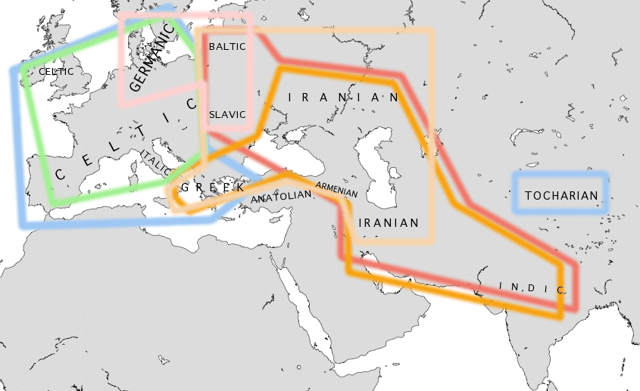
Some significant isoglosses in Indo-European daughter languages at around 500 BC. Blue: centum languages Red: satem languages Orange: languages with augment Green: languages with PIE *-tt- > -ss- Tan: languages with PIE *-tt- > -st- Pink: languages with instrumental, dative and ablative plural endings (and some others) in *-m- rather than *-bh-
The division of the Indo-European languages into satem and centum groups was put forward by Peter von Bradke in 1890, although Karl Brugmann did propose a similar type of division in 1886. In the satem languages, which include the Balto-Slavic and Indo-Iranian branches, as well as (in most respects) Albanian and Armenian, the reconstructed Proto-Indo-European palatovelars remained distinct and were fricativized, while the labiovelars merged with the 'plain velars.' In the centum languages, the palatovelars merged with the plain velars, while the labiovelars remained distinct. The results of these alternative developments are exemplified by the words for "hundred" in Avestan (satem) and Latin (centum)—the initial palatovelar developed into a fricative [s] in the former, but became an ordinary velar [k] in the latter.
Rather than being a genealogical separation, the centum–satem division is commonly seen as resulting from innovative changes that spread across PIE dialect-branches over a particular geographical area; the centum–satem isogloss intersects a number of other isoglosses that mark distinctions between features in the early IE branches. It may be that the centum branches in fact reflect the original state of affairs in PIE, and only the satem branches shared a set of innovations, which affected all but the peripheral areas of the PIE dialect continuum.[54] Kortlandt proposes that the ancestors of Balts and Slavs took part in satemization before being drawn later into the western Indo-European sphere.[55]
Suggested macrofamilies
Some linguists propose that Indo-European languages form part of one of several hypothetical macrofamilies. However, these theories remain highly controversial, not being accepted by most linguists in the field. Some of the smaller proposed macrofamilies include:
Pontic, postulated by John Colarusso, which joins Indo-European with Northwest Caucasian
Indo-Uralic, joining Indo-European with Uralic
Other, greater proposed families including Indo-European languages, include:
Eurasiatic, a theory championed by Joseph Greenberg
Nostratic, comprising all or some of the Eurasiatic languages, as well as the Kartvelian, Uralic, Dravidian (or even the Elamo-Dravidian macrofamily), Altaic, and Afroasiatic language families
Objections to such groupings are not based on any theoretical claim about the likely historical existence or non-existence of such macrofamilies; it is entirely reasonable to suppose that they might have existed. The serious difficulty lies in identifying the details of actual relationships between language families, because it is very hard to find concrete evidence that transcends chance resemblance, or is not equally likely explained as being due to borrowing (including Wanderwörter, which can travel very long distances). Because the signal-to-noise ratio in historical linguistics declines steadily over time, at great enough time-depths it becomes open to reasonable doubt that one can even distinguish between signal and noise.
Evolution
Proto-Indo-European
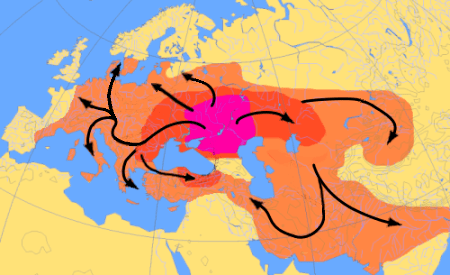
Scheme of Indo-European migrations from ca. 4000 to 1000 BC according to the Kurgan hypothesis.
The proposed Proto-Indo-European language (PIE) is the reconstructed common ancestor of the Indo-European languages, spoken by the Proto-Indo-Europeans. From the 1960s, knowledge of Anatolian became certain enough to establish its relationship to PIE. Using the method of internal reconstruction an earlier stage, called Pre-Proto-Indo-European, has been proposed.
PIE was an inflected language, in which the grammatical relationships between words were signaled through inflectional morphemes (usually endings). The roots of PIE are basic morphemes carrying a lexical meaning. By addition of suffixes, they form stems, and by addition of endings, these form grammatically inflected words (nouns or verbs). The reconstructed Indo-European verb system is complex and, like the noun, exhibits a system of ablaut.
Diversification
The diversification of the parent language into the attested branches of daughter languages is historically unattested. The timeline of the evolution of the various daughter languages, on the other hand, is mostly undisputed, quite regardless of the question of Indo-European origins.
Using a mathematical analysis borrowed from evolutionary biology, Don Ringe and Tandy Warnow propose the following evolutionary tree of Indo-European branches:[56]
David Anthony proposes the following sequence:[58]
Pre-Anatolian (4200 BC)
Pre-Tocharian (3700 BC)
Pre-Germanic (3300 BC)
Pre-Italic and Pre-Celtic (3000 BC)
Pre-Armenian (2800 BC)
Pre-Balto-Slavic (2800 BC)
Pre-Greek (2500 BC)
Proto-Indo-Iranian (2200 BC); split between Iranian and Old Indic 1800 BC
From 1500 BC the following sequence may be given:
1500–1000 BC: The Nordic Bronze Age develops pre-Proto-Germanic, and the (pre)-Proto-Celtic Urnfield and Hallstatt cultures emerge in Central Europe, introducing the Iron Age. Migration of the Proto-Italic speakers into the Italian peninsula (Bagnolo stele). Redaction of the Rigveda and rise of the Vedic civilization in the Punjab. The Mycenaean civilization gives way to the Greek Dark Ages. Hittite goes extinct.
1000–500 BC: The Celtic languages spread over Central and Western Europe. Baltic languages are spoken in a huge area from present-day Poland to the Ural Mountains.[59] Proto Germanic. Homer and the beginning of Classical Antiquity. The Vedic Civilization gives way to the Mahajanapadas. Siddhartha Gautama preaches Buddhism. Zoroaster composes the Gathas, rise of the Achaemenid Empire, replacing the Elamites and Babylonia. Separation of Proto-Italic into Osco-Umbrian and Latin-Faliscan. Genesis of the Greek and Old Italic alphabets. A variety of Paleo-Balkan languages are spoken in Southern Europe.
500 BC–1 BC/AD: Classical Antiquity: spread of Greek and Latin throughout the Mediterranean and, during the Hellenistic period (Indo-Greeks), to Central Asia and the Hindukush. Kushan Empire, Mauryan Empire. Proto-Germanic.
1 BC/ AD 500: Late Antiquity, Gupta period; attestation of Armenian. Proto-Slavic. The Roman Empire and then the Migration period marginalize the Celtic languages to the British Isles. Sogdian, an Eastern Iranian language, becomes the lingua franca of the Silk Road in Central Asia leading to China, due to the proliferation of Sogdian merchants there. The last of the Anatolian languages are extinct.
500–1000: Early Middle Ages. The Viking Age forms an Old Norse koine spanning Scandinavia, the British Isles and Iceland. The Islamic conquest and the Turkic expansion results in the Arabization and Turkification of significant areas where Indo-European languages were spoken. Tocharian is extinct in the course of the Turkic expansion while Northeastern Iranian (Scytho-Sarmatian) is reduced to small refugia. Slavic languages spread over wide areas in central, eastern and southeastern Europe, largely replacing Romance in the Balkans (with the exception of Romanian) and whatever was left of the paleo-Balkan languages with the exception of Albanian.
1000–1500: Late Middle Ages: Attestation of Albanian and Baltic.
1500–2000: Early Modern period to present: Colonialism results in the spread of Indo-European languages to every continent, most notably Romance (North, Central and South America, North and Sub-Saharan Africa, West Asia), West Germanic (English in North America, Sub-Saharan Africa, East Asia and Australia; to a lesser extent Dutch and German), and Russian to Central Asia and North Asia.
Important languages for reconstruction
In reconstructing the history of the Indo-European languages and the form of the Proto-Indo-European language, some languages have been of particular importance. These generally include the ancient Indo-European languages that are both well-attested and documented at an early date, although some languages from later periods are important if they are particularly linguistically conservative (most notably, Lithuanian). Early poetry is of special significance because of the rigid poetic meter normally employed, which makes it possible to reconstruct a number of features (e.g. vowel length) that were either unwritten or corrupted in the process of transmission down to the earliest extant written manuscripts.
Most noticeable of all:[60]
Vedic Sanskrit (c. 1500–500 BC). This language is unique in that its source documents were all composed orally, and were passed down through oral tradition (shakha schools) for c. 2,000 years before ever being written down. The oldest documents are all in poetic form; oldest and most important of all is the Rigveda (c. 1500 BC).
Ancient Greek (c. 750–400 BC). Mycenaean Greek (c. 1450 BC) is the oldest recorded form, but its value is lessened by the limited material, restricted subject matter, and highly ambiguous writing system. More important is Ancient Greek, documented extensively beginning with the two Homeric poems (the Iliad and the Odyssey, c. 750 BC).
Hittite (c. 1700–1200 BC). This is the earliest-recorded of all Indo-European languages, and highly divergent from the others due to the early separation of the Anatolian languages from the remainder. It possesses some highly archaic features found only fragmentarily, if at all, in other languages. At the same time, however, it appears to have undergone a large number of early phonological and grammatical changes which, combined with the ambiguities of its writing system, hinder its usefulness somewhat.
Other primary sources:
Latin, attested in a huge amount of poetic and prose material in the Classical period (c. 200 BC – 100 AD) and limited older material from as early as c. 600 BC.
Gothic (the most archaic well-documented Germanic language, c. 350 AD), along with the combined witness of the other old Germanic languages: most importantly, Old English (c. 800–1000 AD), Old High German (c. 750–1000 AD) and Old Norse (c. 1100–1300 AD, with limited earlier sources dating all the way back to c. 200 AD).
Old Avestan (c. 1700–1200 BC) and Younger Avestan (c. 900 BC). Documentation is sparse, but nonetheless quite important due to its highly archaic nature.
Modern Lithuanian, with limited records in Old Lithuanian (c. 1500–1700 AD).
Old Church Slavonic (c. 900–1000 AD).
Other secondary sources, of lesser value due to poor attestation:
Luwian, Lycian, Lydian and other Anatolian languages (c. 1400–400 BC).
Oscan, Umbrian and other Old Italic languages (c. 600–200 BC).
Old Persian (c. 500 BC).
Old Prussian (c. 1350–1600 AD); even more archaic than Lithuanian.
Other secondary sources, of lesser value due to extensive phonological changes and relatively limited attestation:[61]
Old Irish (c. 700–850 AD).
Tocharian (c. 500–800 AD), underwent large phonetic shifts and mergers in the proto-language, and has an almost entirely reworked declension system.
Classical Armenian (c. 400–1000 AD).
Albanian (c. 1450–current time).
Sound changes
As the Proto-Indo-European (PIE) language broke up, its sound system diverged as well, changing according to various sound laws evidenced in the daughter languages.
PIE is normally reconstructed with a complex system of 15 stop consonants, including an unusual three-way phonation (voicing) distinction between voiceless, voiced and "voiced aspirated" (i.e. breathy voiced) stops, and a three-way distinction among velar consonants (k-type sounds) between "palatal" ḱ ǵ ǵh, "plain velar" k g gh and labiovelar kʷ gʷ gʷh. (The correctness of the terms palatal and plain velar is disputed; see Proto-Indo-European phonology.) All daughter languages have reduced the number of distinctions among these sounds, often in divergent ways.
As an example, in English, one of the Germanic languages, the following are some of the major changes that happened:
None of the daughter-language families (except possibly Anatolian, particularly Luvian) reflect the plain velar stops differently from the other two series, and there is even a certain amount of dispute whether this series existed at all in PIE. The major distinction between centum and satem languages corresponds to the outcome of the PIE plain velars:
The "central" satem languages (Indo-Iranian, Balto-Slavic, Albanian, and Armenian) reflect both "plain velar" and labiovelar stops as plain velars, often with secondary palatalization before a front vowel (e i ē ī). The "palatal" stops are palatalized and often appear as sibilants (usually but not always distinct from the secondarily palatalized stops).
The "peripheral" centum languages (Germanic, Italic, Celtic, Greek, Anatolian and Tocharian) reflect both "palatal" and "plain velar" stops as plain velars, while the labiovelars continue unchanged, often with later reduction into plain labial or velar consonants.
The three-way PIE distinction between voiceless, voiced and voiced aspirated stops is considered extremely unusual from the perspective of linguistic typology—particularly in the existence of voiced aspirated stops without a corresponding series of voiceless aspirated stops. None of the various daughter-language families continue it unchanged, with numerous "solutions" to the apparently unstable PIE situation:
The Indo-Aryan languages preserve the three series unchanged but have evolved a fourth series of voiceless aspirated consonants.
The Iranian languages probably passed through the same stage, subsequently changing the aspirated stops into fricatives.
Greek converted the voiced aspirates into voiceless aspirates.
Italic probably passed through the same stage, but reflects the voiced aspirates as voiceless fricatives, especially f (or sometimes plain voiced stops in Latin).
Celtic, Balto-Slavic, Anatolian, and Albanian merge the voiced aspirated into plain voiced stops.
Germanic and Armenian change all three series in a chain shift (e.g. with bh b p becoming b p f (known as Grimm's law in Germanic).
Among the other notable changes affecting consonants are:
The Ruki sound law (s becomes /ʃ/ before r, u, k, i) in the satem languages.
Loss of prevocalic p in Proto-Celtic.
Development of prevocalic s to h in Proto-Greek, with later loss of h between vowels.
Verner's law in Proto-Germanic.
Grassmann's law (dissimilation of aspirates) independently in Proto-Greek and Proto-Indo-Iranian.
The following table shows the basic outcomes of PIE consonants in some of the most important daughter languages for the purposes of reconstruction. For a fuller table, see Indo-European sound laws.
| PIE | Skr. | O.C.S. | Lith. | Greek | Latin | Old Irish | Gothic | English | Examples | ||||||
|---|---|---|---|---|---|---|---|---|---|---|---|---|---|---|---|
| PIE | Eng. | Skr. | Gk. | Lat. | Lith. etc. | Prs. | |||||||||
| ***p** | **p**; **ph**H | **p** | **Ø**; **ch**T[x] | **f**; `-**b**-[β] | **f**; -**v/f**- | **pṓds ~ ped- | foot | pád- | poús (podós) | pēs (pedis) | pãdas | Piáde | |||
| ***t** | **t**; **th**H | **t** | **t**; -**th**-[θ] | **þ**[θ]; `-**d**-[ð]; **t**T- | **th**; `-**d**-; **t**T- | *tréyes | three | tráyas | treĩs | trēs | trỹs | thri (old Persian) | |||
| ***ḱ** | **ś**[ɕ] | **s** | **š**[ʃ] | **k** | **c**[k] | **c**[k]; -**ch**-[x] | **h**; `-**g**-[ɣ] | **h**; -**Ø**-; `-**y**- | *ḱm̥tóm | hund(red) | śatám | he-katón | centum | šimtas | sad |
| ***k** | **k**; **c**E[tʃ]; **kh**H | **k**; **č**E[tʃ]; **c**E'[ts] | **k** | *kreuh₂ "raw meat" | OE hrēaw raw | kravíṣ- | kréas | cruor | kraûjas | xoreš | |||||
| ***kʷ** | **p**; **t**E; **k**(u) | **qu**[kʷ]; **c**(O)[k] | **ƕ**[ʍ]; `-**gw/w**- | **wh**; `-**w**- | *kʷid, kʷod | what | kím | tí | quid, quod | kas, kad | ce, ci | ||||
| *kʷekʷlom | wheel | cakrá- | kúklos | kãklas | carx | ||||||||||
| ***b** | **b**; **bh**H | **b** | **b**[b]; -**[β]**- | **p** | |||||||||||
| ***d** | **d**; **dh**H | **d** | **d**[d]; | **t** | *déḱm̥(t) | ten, Goth. taíhun | dáśa | déka | decem | dẽšimt | dah | ||||
| ***ǵ** | **j**[dʒ]; **h**H[ɦ] | **z** | **ž**[ʒ] | **g** | **g**[ɡ]; | **k** | **c / k**; **ch**E' | **ǵénu, ǵnéu- | OE cnēo knee | jā́nu | gónu | genu | zánu | ||
| ***g** | **g**; **j**E[dʒ]; **gh**H; **h**H,E[ɦ] | **g**; **ž**E[ʒ]; **dz**E' | **g** | *yugóm | yoke | yugám | zugón | iugum | jùngas | yugh | |||||
| ***gʷ** | **b**; **d**e; **g**(u) | **u**[w > v]; **gu**n−[ɡʷ] | **b**[b]; | **q**[kʷ] | **qu** | *gʷīw- | quick "alive" | jīvá- | bíos, bíotos | vīvus | gývas | ze- | |||
| ***bʰ** | **bh**; **b**..Ch | **b** | **ph**; **p**..Ch | **f**-; **b** | **b**[b]; -**f** | **b**; -**v/f**-(rl) | *bʰerō | bear "carry" | bhar- | phérō | ferō | OCS berǫ | bar- | ||
| ***dʰ** | **dh**; **d**..Ch | **d** | **th**; **t**..Ch | **f**-; **d**; **b**(r),l,u- | **d**[d]; | **d**[d]; -**þ** | **d** | *dʰwer-, dʰur- | door | dhvā́raḥ | thurā́ | forēs | dùrys | dar | |
| ***ǵʰ** | **h**[ɦ]; **j**..Ch | **z** | **ž**[ʒ] | **kh**; **k**..Ch | **h**; **h/g**R | **g**[ɡ]; | **g**; -**g**-[ɣ]; -**g**[x] | **g**; -**y/w**-(rl) | *ǵʰans- | goose, OHG gans | haṁsáḥ | khḗn | (h)ānser | žąsìs | gház |
| ***gʰ** | **gh**; **h**E[ɦ]; **g**..Ch; **j**E..Ch | **g**; **ž**E[ʒ]; **dz**E' | **g** | ||||||||||||
| ***gʷʰ** | **ph**; **th**E; **kh**(u); **p**..Ch; **t**E..Ch; **k**(u)..Ch | **f**-; **g** / -**u**-[w]; n**gu**[ɡʷ] | **g**; **b**-; -**w**-; n**gw** | **g**; **b**-; -**w**- | *sneigʷʰ- | snow | sneha- | nípha | nivis | sniẽgas | barf | ||||
| *gʷʰerm- | ??warm | gharmáḥ | thermós | formus | Latv. gar̂me | garm | |||||||||
| ***s** | **s** | **h**-; -**s**; **s**(T); -**Ø**-; [¯](R) | **s**; -**r**- | **s**[s]; | **s**; `-**z**- | **s**; `-**r**- | *septḿ̥ | seven | saptá | heptá | septem | septynì | haft | ||
| **ṣ**ruki-[ʂ] | **x**ruki-[x] | **š**ruki-[ʃ] | *h₂eusōs "dawn" | east | uṣā́ḥ | āṓs | aurōra | aušra | báxtar | ||||||
| ***m** | **m** | **m**[m]; | **m** | *mūs | mouse | mū́ṣ- | mũs | mūs | OCS myšĭ | muš | |||||
| ***-m** | -**m** | -**˛**[˜] | -**n** | -**m** | -**n** | -**Ø** | *ḱm̥tóm | hund(red) | śatám | (he)katón | centum | OPrus simtan | sad | ||
| ***n** | **n** | **n**; -**˛**[˜] | **n** | *nokʷt- | night | nákt- | núkt- | noct- | naktis | náštá | |||||
| ***l** | **r** (dial. **l**) | **l** | *leuk- | light | rócate | leukós | lūx | laũkas | ruz | ||||||
| ***r** | **r** | *h₁reudʰ- | red | rudhirá- | eruthrós | ruber | raũdas | sorx | |||||||
| ***i̯** | **y**[j] | **j**[j] | **z**[dz > zd, z]/ **h**; -**Ø**- | **i**[j]; -**Ø**- | **Ø** | **j** | **y** | *yugóm | yoke | yugám | zugón | iugum | jùngas | yugh | |
| ***u̯** | **v**[ʋ] | **v** | **v**[ʋ] | **w > h / Ø** | **u**[w > v] | **f**; -**Ø**- | **w** | *h₂weh₁n̥to- | wind | vā́taḥ | áenta | ventus | vėtra | bád | |
| PIE | Skr. | O.C.S. | Lith. | Greek | Latin | Old Irish | Gothic | English | |||||||
- Notes:
C- At the beginning of a word.
-C- Between vowels.
-C At the end of a word.
`-C- Following an unstressed vowel (Verner's law).
-C-(rl) Between vowels, or between a vowel and r, l (on either side).
CT Before a (PIE) stop (p, t, k).
CT− After a (PIE) obstruent (p, t, k, etc.; s).
C(T) Before or after an obstruent (p, t, k, etc.; s).
CH Before an original laryngeal.
CE Before a (PIE) front vowel (i, e).
CE' Before secondary (post-PIE) front-vowels.
Ce Before e.
C(u) Before or after a (PIE) u (boukólos rule).
C(O) Before or after a (PIE) o, u (boukólos rule).
Cn− After n.
CR Before a sonorant (r, l, m, n).
C(R) Before or after a sonorant (r, l, m, n).
C(r),l,u− Before r, l or after r, u.
Cruki− After r, u, k, i (Ruki sound law).
C..Ch Before an aspirated consonant in the next syllable (Grassmann's law, also known as dissimilation of aspirates).
CE..Ch Before a (PIE) front vowel (i, e) as well as before an aspirated consonant in the next syllable (Grassmann's law, also known as dissimilation of aspirates).
C(u)..Ch Before or after a (PIE) u as well as before an aspirated consonant in the next syllable (Grassmann's law, also known as dissimilation of aspirates).
Comparison of conjugations
The following table presents a comparison of conjugations of the thematic present indicative of the verbal root *bʰer- of the English verb to bear and its reflexes in various early attested IE languages and their modern descendants or relatives, showing that all languages had in the early stage an inflectional verb system.
| Proto-Indo-European (*bʰer-'to carry, to bear') | |
|---|---|
| I (1st sg.) | |
| You (2nd sg.) | |
| He/She/It (3rd sg.) | |
| We (1st dual) | |
| You (2nd dual) | |
| They (3rd dual) | |
| We (1st pl.) | |
| You (2nd pl.) | |
| They (3rd pl.) |
| Major subgroup | Hellenic | Indo-Iranian | Italic | Celtic | Armenian | Germanic | Balto-Slavic | Albanian | ||
|---|---|---|---|---|---|---|---|---|---|---|
| Indo-Aryan | Iranian | Baltic | Slavic | |||||||
| Ancient representative | Ancient Greek | Vedic Sanskrit | Avestan | Latin | Old Irish | Classical Arm. | Gothic | Old Prussian | Old Church Sl. | Old Albanian |
| I (1st sg.) | phérō | bhárāmi | barā | ferō | biru; berim | berem | baíra /bɛra/ | *bera | berǫ | *berja |
| You (2nd sg.) | phéreis | bhárasi | barahi | fers | biri; berir | beres | baíris | *bera | bereši | *berje |
| He/She/It (3rd sg.) | phérei | bhárati | baraiti | fert | berid | berē | baíriþ | *bera | beretъ | *berjet |
| We (1st dual) | — | bhárāvas | barāvahi | — | — | — | baíros | berevě | ||
| You (2nd dual) | phéreton | bhárathas | — | — | — | — | baírats | bereta | ||
| They (3rd dual) | phéreton | bháratas | baratō | — | — | — | — | berete | ||
| We (1st pl.) | phéromen | bhárāmas | barāmahi | ferimus | bermai | beremk` | baíram | *beramai | beremъ | *berjame |
| You (2nd pl.) | phérete | bháratha | baraϑa | fertis | beirthe | berēk` | baíriþ | *beratei | berete | *berjeju |
| They (3rd pl.) | phérousi | bháranti | barəṇti | ferunt | berait | beren | baírand | *bera | berǫtъ | *berjanti |
| Modern representative | Modern Greek | Hindustani | Persian | Irish | Armenian (Eastern; Western) | German | Lithuanian | Czech | Albanian | |
| I (1st sg.) | férno | (maiṃ) bharūṃ | (man) {mi}baram | beirim | berum em; g'perem | (ich) {ge}bäre | beriu | beru | (unë) bie | |
| You (2nd sg.) | férnis | (tū) bhare | (tu) {mi}bari | beirir | berum es; g'peres | (du) {ge}bierst | beri | bereš | (ti) bie | |
| He/She/It (3rd sg.) | férni | (vah) bhare | (ān) {mi}barad | beireann; %beiridh | berum ē; g'perē | (er)(sie)(es) {ge}biert | beria | bere | (ai/ajo) bie | |
| We (1st dual) | beriava | |||||||||
| You (2nd dual) | beriata | |||||||||
| They (3rd dual) | beria | |||||||||
| We (1st pl.) | férnume | (ham) bhareṃ | (mā) {mi}barim | beirimid; beiream | berum enk; g'perenk | (wir) {ge}bären | beriame | berem(e) | (ne) biem | |
| You (2nd pl.) | férnete | (tum) bharo | (šomā) {mi}barid | beireann sibh; %beirthaoi | berum ek; g'perek | (ihr) {ge}bärt | beriate | berete | (ju) bini | |
| They (3rd pl.) | férnun | (ve) bhareṃ | (ānān) {mi}barand | beirid | berum en; g'peren | (sie) {ge}bären | beria | berou | (ata/ato) bien | |
While similarities are still visible between the modern descendants and relatives of these ancient languages, the differences have increased over time. Some IE languages have moved from synthetic verb systems to largely periphrastic systems. In addition, the pronouns of periphrastic forms are in brackets when they appear. Some of these verbs have undergone a change in meaning as well.
In Modern Irish beir usually only carries the meaning to bear in the sense of bearing a child; its common meanings are to catch, grab.
The Hindi verb bharnā, the continuation of the Sanskrit verb, can have a variety of meanings, but the most common is "to fill". The forms given in the table, although etymologically derived from the present indicative, now have the meaning of subjunctive. The present indicative is conjugated periphrastically, using a participle (etymologically the Sanskrit present participle bharant-) and an auxiliary: maiṃ bhartā hūṃ, tū bhartā hai, vah bhartā hai, ham bharte haiṃ, tum bharte ho, ve bharte haiṃ (masculine forms).
German is not directly descended from Gothic, but the Gothic forms are a close approximation of what the early West Germanic forms of c. 400 AD would have looked like. The cognate of Germanic beranan (English bear) survives in German only in the compound gebären, meaning "bear (a child)".
The Latin verb ferre is irregular, and not a good representative of a normal thematic verb. In most Romance Languages such as French, other verbs now mean "to carry" (e.g. Fr. porter < Lat. portare) and ferre was only borrowed and nativized in compounds such as souffrir "to suffer" (from Latin sub- and ferre) and conférer "to confer" (from Latin "con-" and "ferre").
In Modern Greek, phero φέρω (modern transliteration fero) "to bear" is still used but only in specific contexts and is most common in such compounds as αναφέρω, διαφέρω, εισφέρω, εκφέρω, καταφέρω, προφέρω, προαναφέρω, προσφέρω etc. The form that is (very) common today is pherno φέρνω (modern transliteration ferno) meaning "to bring". Additionally, the perfective form of pherno (used for the subjunctive voice and also for the future tense) is also phero.
In Modern Russian брать (brat') carries the meaning to take. Бремя (br'em'a) means burden, as something heavy to bear, and derivative беременность (b'er'em'ennost') means pregnancy.
Comparison of cognates
Present distribution
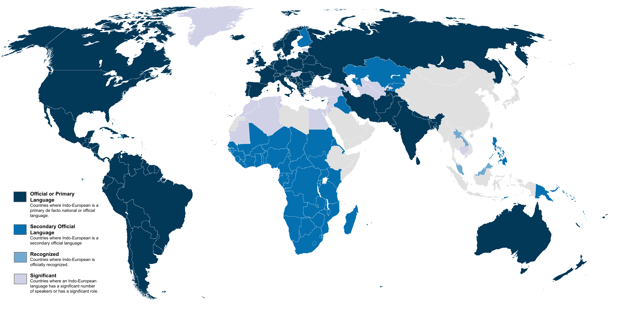
Official or Primary Language Secondary Official Language Recognized Significant No use

The approximate present-day distribution of Indo-European languages within the Americas by country: Romance: Spanish Portuguese–Galician French Germanic: English Dutch
Today, Indo-European languages are spoken by 3.2 billion native speakers across all inhabited continents,[62] the largest number by far for any recognised language family. Of the 20 languages with the largest numbers of native speakers according to Ethnologue, 10 are Indo-European: Spanish, English, Hindustani, Portuguese, Bengali, Russian, Punjabi, German, French and Marathi, accounting for over 1.7 billion native speakers.[63] Additionally, hundreds of millions of persons worldwide study Indo-European languages as secondary or tertiary languages, including in cultures which have completely different language families and historical backgrounds—there are between 600 million[64] and one billion[65] L2 learners of English alone.
The success of the language family, including the large number of speakers and the vast portions of the Earth that they inhabit, is due to several factors. The ancient Indo-European migrations and widespread dissemination of Indo-European culture throughout Eurasia, including that of the Proto-Indo-Europeans themselves, and that of their daughter cultures including the Indo-Aryans, Iranian peoples, Celts, Greeks, Romans, Germanic peoples, and Slavs, led to these peoples' branches of the language family already taking a dominant foothold in virtually all of Eurasia except for swathes of the Near East, North and East Asia, replacing many (but not all) of the previously-spoken pre-Indo-European languages of this extensive area. However Semitic languages remain dominant in much of the Middle East and North Africa, and Caucasian languages in much of the Caucasus region. Similarly in Europe and the Urals the Uralic languages (such as Hungarian, Finnish, Estonian etc) remain, as does Basque, a pre-Indo-European Isolate.
Despite being unaware of their common linguistic origin, diverse groups of Indo-European speakers continued to culturally dominate and often replace the indigenous languages of the western two-thirds of Eurasia. By the beginning of the Common Era, Indo-European peoples controlled almost the entirety of this area: the Celts western and central Europe, the Romans southern Europe, the Germanic peoples northern Europe, the Slavs eastern Europe, the Iranian peoples most of western and central Asia and parts of eastern Europe, and the Indo-Aryan peoples in the Indian subcontinent, with the Tocharians inhabiting the Indo-European frontier in western China. By the medieval period, only the Semitic, Dravidian, Caucasian and Uralic languages, and the language isolate Basque remained of the (relatively) indigenous languages of Europe and the western half of Asia.
Despite medieval invasions by Eurasian nomads, a group to which the Proto-Indo-Europeans had once belonged, Indo-European expansion reached another peak in the early modern period with the dramatic increase in the population of the Indian subcontinent and European expansionism throughout the globe during the Age of Discovery, as well as the continued replacement and assimilation of surrounding non-Indo-European languages and peoples due to increased state centralization and nationalism. These trends compounded throughout the modern period due to the general global population growth and the results of European colonization of the Western Hemisphere and Oceania, leading to an explosion in the number of Indo-European speakers as well as the territories inhabited by them.
Due to colonization and the modern dominance of Indo-European languages in the fields of politics, global science, technology, education, finance, and sports, even many modern countries whose populations largely speak non-Indo-European languages have Indo-European languages as official languages, and the majority of the global population speaks at least one Indo-European language. The overwhelming majority of languages used on the Internet are Indo-European, with English continuing to lead the group; English in general has in many respects become the lingua franca of global communication.
See also
Grammatical conjugation
The Horse, the Wheel, and Language (book)
Indo-European copula
Indo-European sound laws
Indo-European studies
Indo-Semitic languages
Indo-Uralic languages
Eurasiatic languages
Languages of Asia
Languages of Europe
Languages of India
List of Indo-European languages
Proto-Indo-European root
Proto-Indo-European religion
